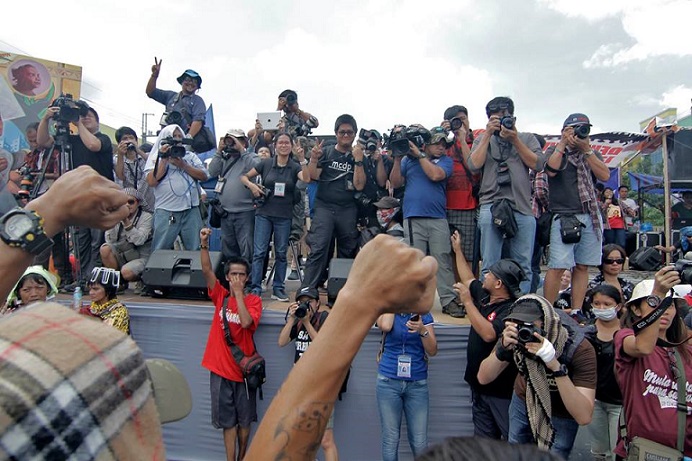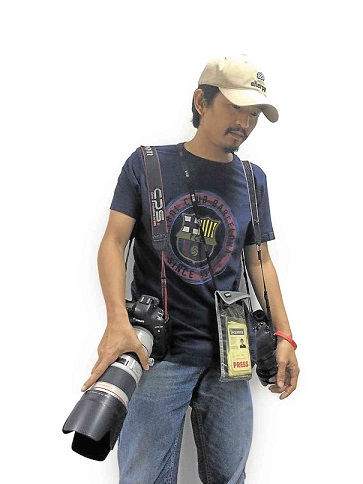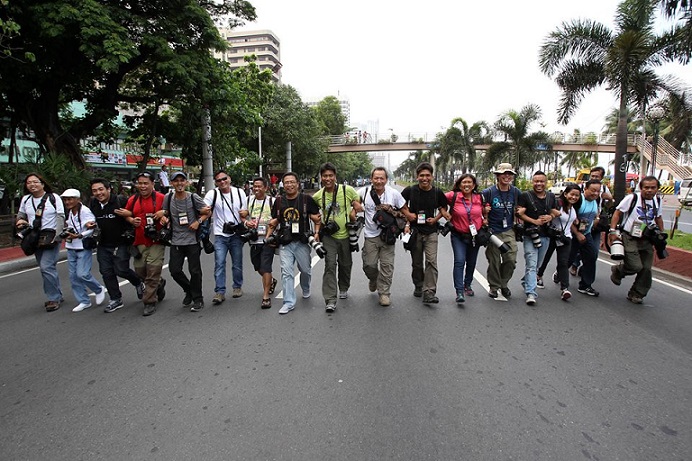
Do you feel sick watching daily images on TV and newspapers of people killed, lying lifeless on the sidewalks covered with newspapers or plastic with only their dirty feet and worn-out rubber slippers seen?
And of course near the corpse, the cardboard sign “Drug pusher ako, huwag tularan”, which has now become a standard accessory in President Duterte’s war against illegal drugs.
Studies have shown the ill-effects of being exposed to traumatic images.
In an article in the website of Association for Psychological Science, psychological scientist Roxane Cohen Silver of the University of California, Irvine and colleagues said “repeated exposure to vivid traumatic images from the media could lead to long-lasting negative consequences, not just for mental health but also for physical health. “
The article said Silver and her colleagues “speculated that such media exposure could result in a stress response that triggers various physiologic processes associated with increased health problems over time.”
That’s for those who are exposed to disturbing images in media. How much more with members of media who are up close to those gruesome scenes to capture them for the people to know what’s happening in the country.

“Hindi bumababa sa lima ang patay bawat araw, minsan 10, may araw na 18. If I will add everything for that week, it would be more than the total for the year when I first did the nightshift in 2005,” he said.
Lerma related the anguish that he and his fellow photographers also go in covering the Duterte administration’s drug war.
He said when he went to Pasay City Rotonda in the early hours of July 22, it was the third death for that night that he had to cover.
Lerma said Olaires was pleading for help as he and the photographers were taking pictures but they couldn’t do anything. The area had been cordoned by the police.
After that, they went to Leveriza st, also in Pasay, which is now being grimly referred to as “Patay City.”Another killing. But the body of the victim – said to be a person with speech disability- had already been removed from the crime scene.
Lerma related, “We were quiet as we went back to the Manila Police District, the office of graveyard-shift media workers. I lighted a cigarette to calm my nerves. Another photographer took deep breaths. Together, we recounted moments from the scene at Pasay Rotunda.
“Another veteran photographer said, while shaking his head, ‘’ no longer want to be a photographer.” We all had the same feeling of guilt.”
In the end, Lerma said, they consoled themselves that it’s part of the job.

Dr. Elana Newman, a licensed clinical psychologist who conducted a survey of 800 photojournalists, in an article at the Dart Centre website, said, “Witnessing death and injury takes its toll, a toll that increases with exposure. The more such assignments photojournalists undertake, the more likely they are to experience psychological consequences.”
Dart Centre Europe, a regional hub for journalists and filmmakers who believe that effective reporting on violence and trauma matters, has a 40-page guide by Joe Hight and Frank Smyth to help journalists, photojournalists and editors report on violence while protecting both victims and themselves.
For the journalists, here are some advice:
1. Know your limits. If you’ve been given a troublesome assignment that you feel you cannot perform, politely express your concerns to your supervisor. Tell the supervisor that you may not be the best person for the assignment. Explain why.
2. Take breaks. A few minutes or a few hours away from the situation may help relieve your stress.
3. Find someone who is a sensitive listener. It can be an editor or a peer, but you must trust that the listener will not pass judgment on you. Perhaps it is someone who has faced a similar experience.
4. Learn how to deal with your stress. Find a hobby, exercise, attend a house of worship or, most important, spend time with your family, a significant other or friends – or all four. Try deep-breathing..
5. Understand that your problems may become overwhelming. Before he died in April 1945, war correspondent Ernie Pyle wrote, “I’ve been immersed in it too long. My spirit is wobbly and my mind is confused. The hurt has become too great.” If this happens to you, seek counseling from a professional.
grabe araw2x may pinapatay wala ng justice dito kahit wala hawak ma drugs hinuhuli..
Think about the Children exposed to these types of violence and imagine the kids being desensitized from these senseless violence of what will become of them when they grow up..
Tapos ang paliwanag ni Pdutz sa mga napapatay: “Ganun talaga”.
Expect more bodies of kahit sino na lang lying dead on the streets.
Nakaka-anxiety seeing all these on tv, papers and internet. Maswerte ako at pwede magbakasyon anytime from all these, eh ang mga photojourns apektado sagad buto araw-araw… my heart goes out to them kahit sabihin trabaho lang yan.
I help myself by turning off the TV whenever dead bodies on the streets are shown. Or else I would not be able to sleep.
I imagine how it is with photo-journalists who do not have the option to look away.
One of the tips said, “Try deep- breathing.”
Malaking tulong talaga yan to regain your balance. Yoga would be a good activity.
Ellen,
what i have observed is Graphic images like victims of accidents and or shooting victims are not “shown” in the pages of the Dailies or the broadcast news in graphic details but most only the stories and some background images..Suspects are never presented to the Media, in fact the Cops shield them if there are media personnel around to protect the presumption of innocence of the suspects…
We have countless suicides in our Subway lines (that there are proposal to put up fences at the estimated cost of $ 10 millions plus per station and at present there are 69 subway stations), we only have the guts feelings when the station is closed temporarily without the Transit authority giving the specific reason…(suicide is a private and confidential unless it is for the public interest, like a crime is committed or the person involved is public official) and Traffic accident victims graphic images is totally censured by the Media itself…it is understood that a person run over by a bus or an 18 wheeler or shot multiple times by criminals or cops is not for the pages of the Family newspaper of public Television…
“The smallest minority on earth is the individual. Those who deny individual rights cannot claim to be defenders of minorities.” – Ayn Rand
First they came for the Drug pusher and I did not speak out because I was not a Drug pusher.
Then they came for the Criminals and I did not speak out because I was not a Criminal.
Then they came for the oligarch and I did not speak out because I was not a oligarch.
Then they came for me and there was no one left to speak out for me…….an adaptation of a poem by NIEMOLLER
There is no real war against drugs. It’s Duterte’s way of preparing the nation for a fascist dictatorship. Look, the police are back in their old ways again, shades of Martial Law. In a short while, the military will follow suit.
Why is Peter Lim still alive? Why are there no dead bodies from the plush gated villages of the villages? No addicts and pushers there?
There is no real war against drugs. It’s Duterte’s way of preparing the nation for a fascist dictatorship. Look, the police are back in their old ways again, shades of Martial Law. In a short while, the military will follow suit.
Why is Peter Lim still alive? Why are there no dead bodies from the plush gated villages of the rich and famous? No addicts and pushers there?
why not try looking at the other side of duterte? bakit hindi pahapyawan ng pansin ang kanyang soft side na nagpapakita ang isang taong mapagkalinga sa kanyang nasasakupan? ‘yung opisyal na nasabugan ng landmine na itinanim ng mga NPA na naging sanhi ng pagkabulag na pinangakuan niyang kukupkupin, aalagaan, gagawing bagong tao at bibigyan ng bagong buhay. gayundin, ang kanyang tuwirang pagtukoy sa CPP/NPA sa baluktot na parran ng paggamit ng landmine na kumikitil hindi lamang ng mga kawal at pulis kundi ng mga inosenteng sibilyan bilang pagpapakita ng malasakit sa kapakanan at kaligtasan ng mga walang kinalamang nadadamay dahil sa paggamit ng dahas ng mga rebelde. at marami pang ibang announcements na nagbibigay biyaya at pabor sa mga maliliit na kawani ng pamahalaang HINDI pinagpakitaan ng tunay na malasakit ng ibang nakaraang administrasyon partikular ang gobyerno ni abnoy.
maaaring sobrang matigas ang desisyon ng presidente sa kanyang kampanya laban sa droga PERO sinabi na niya ito noong panahon ng kampanya at ganu’n nang panahon mismo ng halalan. bakit ibinoto pa rin siya at hindi ikinonsidera ang ganitong magiging senaryo? noong kanyang inagurasyon ay inulit niya pa bilang patunay na hindi siya nagbibiro upang labanan ang droga. bakit hindi natinag ang mga drug lords at kanilang mga protektor? dahil ba iniisip at inaakala nilang isang katulad din ng walang bayag na noynoy ang presidente ngayon?
30 years after martial law, from the mother to the son, ganun din sa iba pang namuno, SINONG PRESIDENTE ang buong tapang na nilabanan ang droga?
Sa mga big time na drug pusher ay sangkot ang pangalan ni Peter Co. Hindi ba puwede na si Peter Co ay kunin sa bilibid at kunwari dalhin sa camp crame at sa sasakyan ay barilin at sabihin lumaban, nang agaw ng baril. Kasi marami ng nangyari na habang sakay ay nababaril dahil nang aagaw daw ng baril. Hindi ba puwede gawin iyon para sa isang Peter Co. Nagtatanong lang po.
Mga pipitsuging street pushers lang ang kaya ni Duterte. At kawawa mga ‘to dahil dedo agad, walang due process. Hindi naman lahat ng offenses sa Dangerous Drugs Law ay capital punishment ang parusa. Calibrated po. Pero wala nang ganun pag pobre ka, karatula lang at bala ang katapat mo.
On the other hand, kapag may dugong tsekwa ka at mayaman gaya ni Peter Lim–bibigyan ka pa ng presidential audience. At sa kaso naman ng mga mayors (tulad ni Espinosa), billeted ka pa sa White House sa Camp Crame, masarap ang tsibog at aircon. Ay teka pala, anyare na ba sa 5 police generals?
So anong successful campaign pinagsasabi ni Duterte at mga tagahanga niya? Ni hindi nga kayang akuin ng pulis kung sila ang tumigbak sa mga karatula cadavers. Di ba sintomas yan ng supot na pulisya? At supot na pangulo?
jcj2013 tama ka bakit hindi daw kinulong si espinosa kasi daw kulang sa ebidensya pero shoot to kill ang hatol.
#11. jcj2013, si Peter Lim ay malamang may malakas na konek na hinid mapahindian kaya may presidential audience pa.
#13. Magkukumpare sila ni DU30, Manny Villar, at Peter Lim sa isang kasal kung saan ninong silang tatlo. Akala ko pag lapag pa lang sa NAIA tepok na si Lim. Drowing lang yata.